Finding The Okunevo Moon Man
The Okunev are a group of bronze age people from the Minusinsk Hollow Basin in Russia approximately in the third and second millennium before the current era; thats roughly 4500 years ago from now. They are typed as pastoral animal herders and are known mostly because they drew some pretty strange things on their stones:
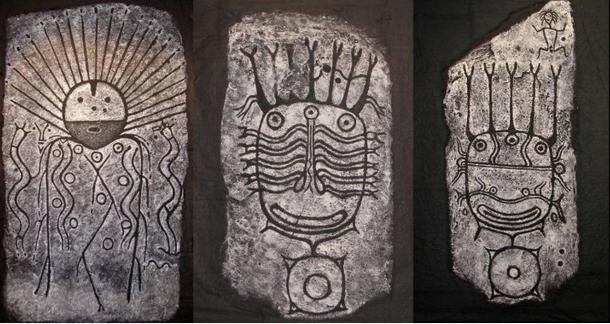
The general idea historians have about these pictures, is that these “Statues and petroglyphs represent three-eyed zoo-anthropomorphic masks, fantastic beasts and bulls.” These faces then are taken to be pictures of deities, or spirits or just even fantasy. We see the face, because of the eyes and mouth. You might even imagine having a conversation with it..
Popular opinion on the faces
Pytheas @ World History forum
And the most outstanding monuments of Okunevo period — the stone statues and steles — clearly show to us, that people living at that time saw and understood a great deal about spirits. Strange and often monstrous figures look at us from the stones with their three eyes. Many of them have horns or sprouts growing from the three-piece mask. They do not have noses: only nostrils and usually an accented mouth. Above the main masks there are two vertical lines, and between them there are smaller masks and some signs. All this composition is crowned with a sheep’s head or with an additional mask. Below the main central mask, the chest and the belly are often depicted, converting into the snout of a beast, if you take a side view. Usually on the chest or on the side of the mask there are circles with four sprouts. Often the “third eye” in the centre of the forehead has the same pattern.
Who are these monsters? There are many possibilities, but no current hypothesis. The author himself supposes that we deal with various spiritual creatures, belonging mostly to the lower world. And who these creatures were — gods or demons, or simply spirit-allies — I cannot say right now.
A russian researcher, D.A. Machinsky, puts more rational analysis into his explanation of the images. (His predisposition is however also that these must be faces):
“The faces, bulging relief and ovoid, are placed on a high stele in the middle part of the narrow side and are turned to the east, which is typical for all solar cults. There are three eyes on the face (The third eye in the middle of the forehead), which corresponds to the body of clairvoyance in the indo-Tibetan esoteric tradition — Anja chakra; two nostrils, wide enough for a deep breath, may indicate the practice of pranayama; and mouth with the corners up conveys the state of bliss and enlightenment...
...On most stele chakras marked in the form of a circle with four petals, arranged on a central axis under the face, and sometimes at the sides and back. The scientist noticed and interesting pattern: on the steles are marker only the upper chakras (four to seven) which may be explained only by the presence of the cult of the virgin-goddess.
Exagerated ovoid faces, and the location near some of stone steles with “eggs” with faces, as well as archeaologichal finds in the Minusinsk Hollow Basin area of egg-shaped vessels, dating from the third millennium BC — all this testitfies to the presence and distribution in siberia of universal myth of the World Egg as a primary form of cosmic energy potential.”
Accoording to D.A. Machinsky, the described images represent the type of enlightend person who realized the practices of spiritual ascent and descent, of internal struggles and enlightenment.
One eye too far
Hmmm…
So I had a sit down and think about this business with three eyes. I dont have three eyes, birds dont have 3 eyes.. Raindeer dont have 3 eyes… “What has three eyes?” — Well, nothing apparently. Besides, there is more strangeness in the Okunev faces. What is with the split from left to right on the face, and the little balls and branches sitting on it…
I spent a few hours looking over many examples of Okunevo ‘faces’. And... no. I was not convinced it was a face, I believe it to be a case of pareidolia to see a face here. Our deities have always looked like us, or like familiar animals. Not like a creature with unidentifiable appendages and odd facial configurations.
If you look back at the first photograph, you should notice that the middle example has a kind of radio tower right in the middle of it; it connects the smaller circles or ovals down below to one of the ‘eyes’. What does that mean? The radio tower icon pops up on many other okunev rock art; its a fixed part of the language these people write their rock art in.
But, then what does the pictogram represent?
I decided to take some of the examples I had gathered and abstracted those to just the lines of the faces.
The Sun Soldier
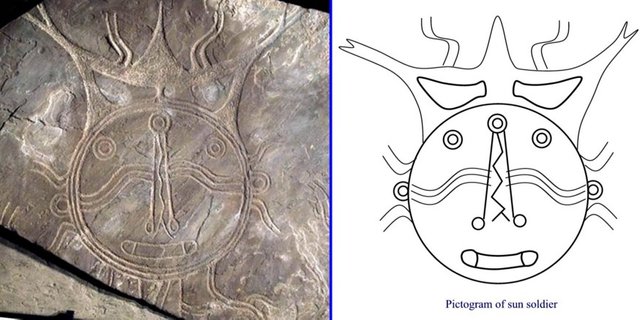
I have to start with this one. It is the most iconic and crisp example of the faces. The picture shows a round face with streamers coming off, and a crown of horns and streamers on top. There are three circles above the wavy lines, and there is a bean shaped cocoon at the bottom of the inner circle. Two seeds seem to hang from the middle circle, penetrating, or interrupting the wavy lines. There is a forked lighting-like streamer coming down from the center circle.
The Red Head
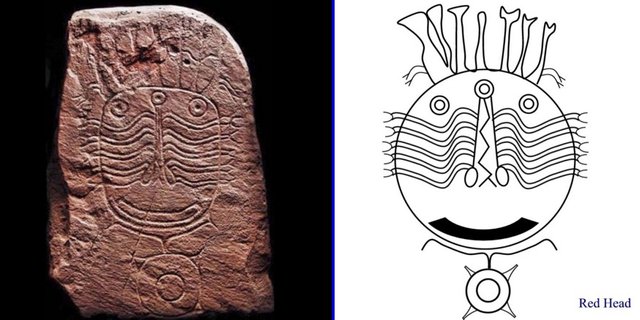
This face has many of the same features as the Sun Soldier; 3 circles, lighting shaft, seeds, wavy lines (with little claws on them), the cocoon and antlers (which I did not do a very good job at drawing this time.)
Additionally, this face is ‘held up’ by a 4th circle, with a shining star behind it. Red head still has crescent moon like features on wavy lines attached to the lightning shaft.
The Moon Man

At a first glance, the stone seems to have a face on it. Do not be fooled again by the apparent eyes and mouth. The line drawing partly removes the feeling of a face. Instead, we see 13 part moons arranged radially about a central ‘lighting shaft’ either directly, or through one of the three circles.
The cocoon is also present again, and has its own, downward pointing crescent moon attached to it. The cocoon plus its downward semi-sphere are not connected to the rest of the image, it is separate from the rest of the drawing. (Note: I am not fully convinced it is a moon. It may well be another circular symbol as we see in Red Head below the main face. This hails to the idea that one world rests on another one from tengri -shamanic- mythology.)
We also still have the wavy lines. They are connecting the lighting shaft to the moons. In my opinion it has no intention to present a face to the viewer, there is no artistic intent to visualize a being or deity in human form. It is showing us a diagram.
A diagram interpretation of the Okunevo art
There are a few dozen Okunevo examples to look at, all varying in design in some way. They do however almost always contain the same set of recurring components, as pointed out in the three examples before. It is these recurring parts that indicate a mechanism in the diagram.
A possible explanation
After the many years that these enigmatic images have kept me busy , I have developed a number of thoughts on what the pattern might be. In short, I believe the pattern distills into a solar and lunar calendar. It is rooted in a cycle of death, rebirth and rise of the sun, guided by the ever changing moon.

The ‘eyes’ may be seen as spring and fall equinox, where as the central eye represents midsummer’s sun. The cocoon (mouth) sits at midwinter.
The drawing has 13 moons. This is interesting because a full solar year, 365 days, is close to 13 lunar months, approximately 360 days. The moons are also connected to the central shaft that has a zig-zag going up it. Now follow this reasoning and see if you like it;
Starting with the bottom left moon, go clockwise round the moons. After thirteen moons, you have completed a full year, almost. The 'eyes' then represent moments in the year that occur at the third, seventh and tenth month; the equinoxes and midsummer.

Now, the reason for choosing the image shown on the right here, is to also show that the Okunev had the concept of the birthgiving/fertile mother; she sits in the top right hand corner of this stone from Siberia. The (re)birth, cyclical concept of life is supposedly connected here to a monsterly face; this is not a very logical connection.
The mother figure with the arms and legs spread show up across the world. This example is from Kakadu National Park in Australia. Estimates for its creation go back to 65.000 years ago. Note that the figure seemingly has its spine marked out.

Another example exists in Gobekli Tepe in the current state of Turkey. The work done at Gobekli Tepe is generally dated at 10.000 years ago.

A point to muse on here, is the fact that the mother figure is a shaft from bottom to top, clearer marked in the australian art. The spread of arms and legs are reminiscent of other siberian rock art and also of images found on shamanic drums.




The Okunevo faces and shamanic drums are alot younger than the australian and turkish figures representing fertility and reproduction. Still, some Okunevo rock artist thought he or she needed to place a great mother image with the face — at least 6500 years since the rock art at Gobekli Tepe. Siberian shamans, thousands years after the Okunev, still use a variant of the image on their drums.
A carefull conclusion
I have been at this subject for eight years now. The best conclusion I can come to, is that the Okunevo are part of a larger tradition of solar observing cultures, but found a unique way of expressing that. They are not the start of this tradition, nor the end of it; just a passing station with its own local flavour. (Following articles will expand on and show where the same concept exists in other cultures.)
The relatively large variety of expressions in the Okunevo imagery shows an evolution of the symbol where it almost seems as if they are trying to integrate two seperate ideas; that of the birthing mother goddess and that of the cyclical nature of the sun, seasons and solar highlights of the year — topics that easily lead to each other.
I will leave you with an overview of images from the Okunevo for you to ponder whether these are monsterous faces, calendars or something entirely else..






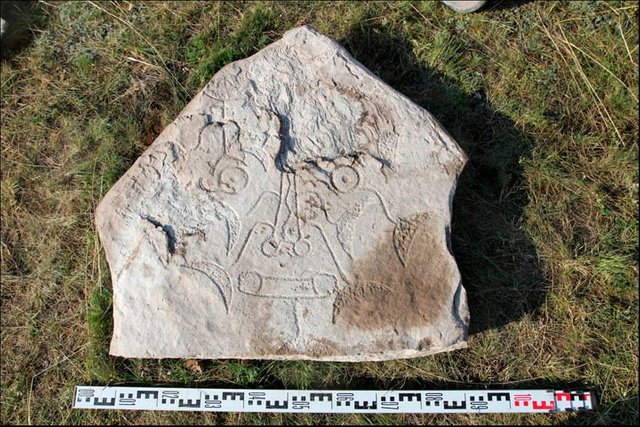
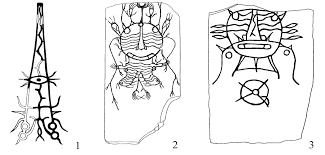
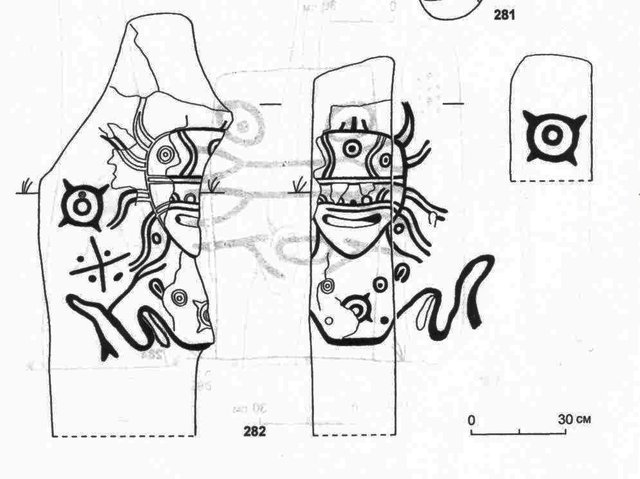
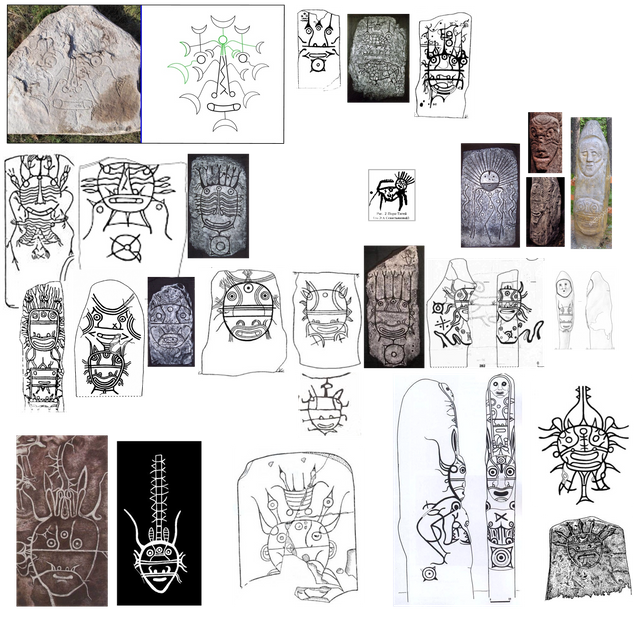
Congratulations @markjohnwiseman! You have completed the following achievement on the Steem blockchain and have been rewarded with new badge(s) :
You can view your badges on your Steem Board and compare to others on the Steem Ranking
If you no longer want to receive notifications, reply to this comment with the word
STOPVote for @Steemitboard as a witness to get one more award and increased upvotes!